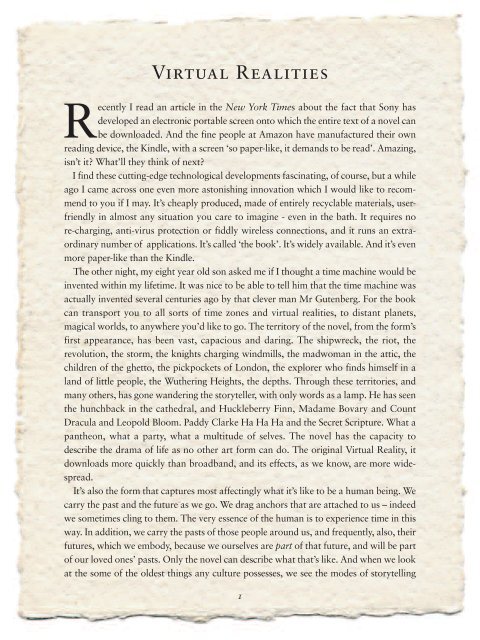The Cathach 2011 - Volume II (PDF) - Sligo Libraries
The Cathach 2011 - Volume II (PDF) - Sligo Libraries
The Cathach 2011 - Volume II (PDF) - Sligo Libraries
Create successful ePaper yourself
Turn your PDF publications into a flip-book with our unique Google optimized e-Paper software.
Virtual Realities<br />
Recently I read an article in the New York Times about the fact that Sony has<br />
developed an electronic portable screen onto which the entire text of a novel can<br />
be downloaded. And the fine people at Amazon have manufactured their own<br />
reading device, the Kindle, with a screen ‘so paper-like, it demands to be read’. Amazing,<br />
isn’t it? What’ll they think of next?<br />
I find these cutting-edge technological developments fascinating, of course, but a while<br />
ago I came across one even more astonishing innovation which I would like to recommend<br />
to you if I may. It’s cheaply produced, made of entirely recyclable materials, userfriendly<br />
in almost any situation you care to imagine - even in the bath. It requires no<br />
re-charging, anti-virus protection or fiddly wireless connections, and it runs an extraordinary<br />
number of applications. It’s called ‘the book’. It’s widely available. And it’s even<br />
more paper-like than the Kindle.<br />
<strong>The</strong> other night, my eight year old son asked me if I thought a time machine would be<br />
invented within my lifetime. It was nice to be able to tell him that the time machine was<br />
actually invented several centuries ago by that clever man Mr Gutenberg. For the book<br />
can transport you to all sorts of time zones and virtual realities, to distant planets,<br />
magical worlds, to anywhere you’d like to go. <strong>The</strong> territory of the novel, from the form’s<br />
first appearance, has been vast, capacious and daring. <strong>The</strong> shipwreck, the riot, the<br />
revolution, the storm, the knights charging windmills, the madwoman in the attic, the<br />
children of the ghetto, the pickpockets of London, the explorer who finds himself in a<br />
land of little people, the Wuthering Heights, the depths. Through these territories, and<br />
many others, has gone wandering the storyteller, with only words as a lamp. He has seen<br />
the hunchback in the cathedral, and Huckleberry Finn, Madame Bovary and Count<br />
Dracula and Leopold Bloom. Paddy Clarke Ha Ha Ha and the Secret Scripture. What a<br />
pantheon, what a party, what a multitude of selves. <strong>The</strong> novel has the capacity to<br />
describe the drama of life as no other art form can do. <strong>The</strong> original Virtual Reality, it<br />
downloads more quickly than broadband, and its effects, as we know, are more widespread.<br />
It’s also the form that captures most affectingly what it’s like to be a human being. We<br />
carry the past and the future as we go. We drag anchors that are attached to us – indeed<br />
we sometimes cling to them. <strong>The</strong> very essence of the human is to experience time in this<br />
way. In addition, we carry the pasts of those people around us, and frequently, also, their<br />
futures, which we embody, because we ourselves are part of that future, and will be part<br />
of our loved ones’ pasts. Only the novel can describe what that’s like. And when we look<br />
at the some of the oldest things any culture possesses, we see the modes of storytelling<br />
1


